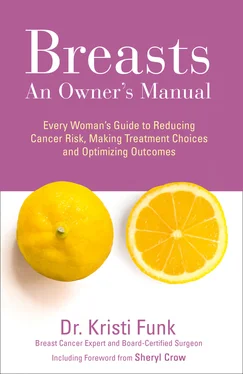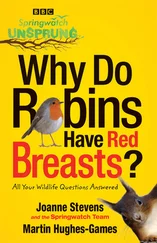It’s important to note, however, that the World Health Organization has confirmed a probable association between breast implants and the rare development of anaplastic large cell lymphoma (ALCL), a cancer of the immune system, but that is not the breast, and ALCL is not breast cancer. 55Implant-associated ALCL occurs in approximately 1 per 5,000 women with textured implants (rarely with smooth implants) and presents with fluid forming around the implant an average of eight years after placement. Thankfully, just removing the implant and the capsule that forms around it completely cures 97.5 percent of women. If needed, those affected can receive a targeted antibody-drug called brentuximab; chemotherapy and radiation are rarely indicated.
We also know that while implants don’t cause cancer, augmentation and implants after mastectomy can present long-term complications, including changes in nipple or breast sensation, undesirable implant positioning, implant rupture, tight scar tissue around the implant (capsular contracture), or persistent pain.
On the other end of the spectrum, you should also know that no link exists between breast reduction surgery (reduction mammoplasty) and breast cancer. In fact, you may actually see a decrease in breast cancer risk. Medical literature supports the notion that breast reduction surgery decreases risk consistently around 30 to 40 percent, with even higher numbers reported when removing two cup sizes (over six hundred grams) of tissue per breast. 56By removing additional ducts and lobules that carry the potential to become cancerous, there aren’t as many around to cause trouble. 57Another prevailing theory as to why reductions help suggests that removing fat (i.e., adipose tissue) favorably changes the world where breast cells live, called the microenvironment . 58
While we’re on the topic, you should know that breast size doesn’t directly affect risk either; small-breasted women don’t have less risk of breast cancer than large-breasted ones. However, there’s one connection between breast size and cancer when analyzing the composition of your breast tissue. 59Remember, the more ducts and lobules you have (as opposed to adipose tissue), the more cells you possess that can become cancerous. To demonstrate, a prospective study compared self-reported bra size and cancer risk among of 88,826 premenopausal women followed for eight years. 60They held a number of factors constant so as to isolate the effect of breast size. After stratification by body mass index (BMI), they found a significant trend for increasing bra cup size and greater breast cancer risk in one and only one group—the leaner women. Among overweight or obese women, no association between bra cup size and breast cancer was found.
In other words, leaner women with generous breasts have more breast cancer precisely because they have very little fat, and therefore, a lot more glandular tissue. More glandular tissue simply equals more breast cancer risk. In this group of 420 leaner women with breast cancer, 96 percent wore smaller than a D-cup, so the subgroup of large-breasted lean women at risk due to size alone is small. The vast majority of large breasts are large because of all the fat surrounding the glandular tissue (and as stated, this fat is very unlikely to become cancerous). Conversely, small breasts generally have less fat, and potentially have the same net volume of glandular tissue as many larger breasts. Therefore, in the final analysis, women should have a similar incidence of breast cancer risk irrespective of their breast volume. The majority of studies attempting to correlate size to risk conclude that no such association exists. 61
ACHOO! CAN YOU “CATCH” BREAST CANCER?
Wondering if you can catch breast cancer or give it to someone else—whether it’s by breathing it through the air, or from exposure to bodily fluids such as breast milk, blood, and saliva, or from sharing utensils, kissing, or having sex—might at first seem ridiculous. But this is actually a real question I’m asked. So here’s your real answer.
When the DNA within a breast cell mutates, that cell starts to grow and divide and spread without control or order; that’s how cancer happens. And that’s the only way it starts. Exposure to someone else’s mutated breast cell doesn’t do anything to your own cells’ DNA. Yet several studies have shown that many people believe breast cancer to be contagious; these findings suggest a pressing need to develop breast cancer educational programs. 62
What’s encouraging is that in 1964, 20 percent of residents interviewed in Perth, Australia, believed that cancer is contagious; however, when that same interview was repeated forty years later, only 3 percent expressed that same belief. 63In other words, improved education about health issues can impact beliefs. We need effective community-based interventions that target the demographics most vulnerable to these faulty myths, which tend to be recent immigrants and those of lower socioeconomic status. Busting myths can change behavior and, in turn, improve cancer outcomes.
SEND ME YOUR BREAST MYTHS!
Heard of another myth and you just can’t figure out the truth? I want to hear about it! Head on over to pinklotus.com/breastmythsand tell me more. I choose the best myth submissions and debunk them for you on our Pink Lotus Power Up blog.
PART 2
REDUCING CANCER RISK
Конец ознакомительного фрагмента.
Текст предоставлен ООО «ЛитРес».
Прочитайте эту книгу целиком, купив полную легальную версию на ЛитРес.
Безопасно оплатить книгу можно банковской картой Visa, MasterCard, Maestro, со счета мобильного телефона, с платежного терминала, в салоне МТС или Связной, через PayPal, WebMoney, Яндекс.Деньги, QIWI Кошелек, бонусными картами или другим удобным Вам способом.












